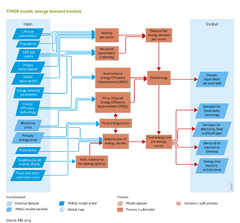Energy demand: Difference between revisions
Jump to navigation
Jump to search
m (Text replace - "Drivers" to "Scenario drivers") |
No edit summary |
||
| Line 1: | Line 1: | ||
{{ComponentTemplate2 | {{ComponentTemplate2 | ||
|Status=Publishable | |Status=Publishable | ||
|Application=Resource Efficiency; | |||
|IMAGEComponent=Energy supply and demand; Energy conversion; Energy supply; Scenario drivers; Human development; Forest management; | |IMAGEComponent=Energy supply and demand; Energy conversion; Energy supply; Scenario drivers; Human development; Forest management; | ||
|KeyReference=Daioglou et al., 2012; Girod et al., 2012; Van Ruijven et al., 2012; | |KeyReference=Daioglou et al., 2012; Girod et al., 2012; Van Ruijven et al., 2012; | ||
| Line 23: | Line 21: | ||
# price-based fuel substitution (i.e. the choice of energy carrier on the basis of its relative costs). | # price-based fuel substitution (i.e. the choice of energy carrier on the basis of its relative costs). | ||
The ways in which these factors are implemented varies across the different sectors. For some sectors, a detailed end-use service-oriented modelling approach was implemented. For other sectors, the description is more generic and aggregate. It should be noted that energy prices link the demand modules with other parts of the energy model, as they respond dynamically to changes in demand, supply and conversion. | The ways in which these factors are implemented varies across the different sectors. For some sectors, a detailed end-use service-oriented modelling approach was implemented. For other sectors, the description is more generic and aggregate. It should be noted that energy prices link the demand modules with other parts of the energy model, as they respond dynamically to changes in demand, supply and conversion. | ||
|ComponentCode=ED | |||
|AggregatedComponent=Energy supply and demand | |||
|FrameworkElementType=pressure component | |||
}} | }} | ||
Revision as of 15:29, 20 December 2013
| Component is implemented in: |
|
| Related IMAGE components |
| Projects/Applications |
| Key publications |
Key policy issues
- How will energy demand evolve particularly in emerging and medium- and low-income economies?
- What is the mix of end-use energy carriers to meet future energy demand?
- How can energy efficiency contribute to reducing the growth rate of energy demand and mitigate pressures on the global environment?
